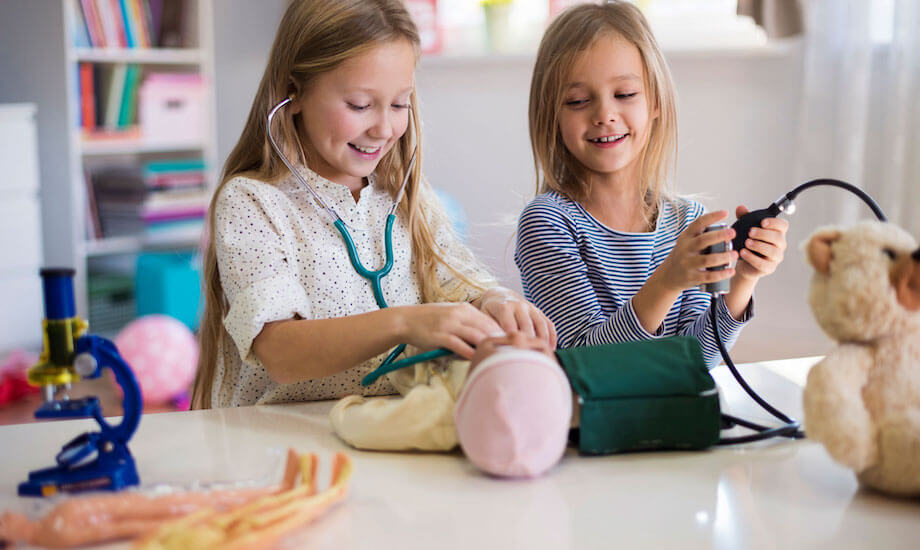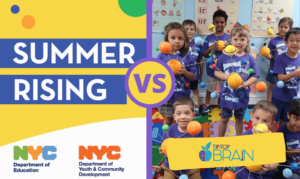Play is essential for child development as play is child’s work. In other words, children learn through play! Play is more complicated than you might think. For instance, did you know there were 10 different types of play? Further, there are many benefits of play such as obtaining knowledge, social-emotional development, problem-solving, reasoning, spatial awareness, and more. Play provides children with the opportunity to challenge their beliefs about the world.
One of the most important benefits of play is it’s impact on brain development, as play is one of the first opportunities your child discovers. For example, a child may feel proud of their tall block tower and disappointed when the tower falls over. Play allows children to express their emotions and eventually regulate them. You may see the child waver as they contemplate giving up, asking for help, or starting over. Through play, children can practice decision-making and learn how to tackle problems independently. As play connects children with their environment and imagination, we must understand the many different forms of play.
The 10 Types of Play
- Unoccupied Play: In the early months of infancy your child participates in unoccupied play. Children can be seen making random movements and moving their bodies around. This is the earliest form of play.
- Solitary Play: From three to eighteen months, babies participate in solitary play. During solitary play, children explore their surroundings as they grab and push over objects. Solitary play allows for children to take time and make meaning of the world around them.
- Onlooker Play: Onlooker play typically occurs during the toddler years. This type of play involves watching other children play. Children observe their peers and notice different ways they can relate to them. Children may observe the ongoing play and participate the following time.
- Parallel Play: Parallel play occurs from the age of eighteen months to two years. Children begin to play alongside other children without interaction or interruption. Parallel play provides your child with opportunities for pretending.
- Associative Play: Associative play occurs when children are around three to four years of age. Children begin to socialize with their peers and practice skills such as sharing, language development, and problem-solving skills. In associative play, groups of children have similar goals.
- Physical Play: Physical play occurs when children run, jump, and move their bodies around. Physical play offers a chance for children to exercise, develop gross motor skills, and develop muscle strength.
- Constructive Play: During constructive play children create all sorts of things. Constructive play evolves over time. For example, an infant putting objects in their mouth to understand taste to a toddler using their finger to draw in mud. Constructive play allows children to explore, discover patterns, gain confidence, manipulate objects, and be creative!
- Expressive Play: Expressive play can help children learn to express and regulate emotions.Children can engage in play by using varied materials to express themselves. Children can participate in open-ended art processes as they use clay, watercolor, and oil pastel to experience different textures. Music and musical instruments are also used in expressive play. Children may stomp, clap, or hum to express themselves.
- Fantasy Play: During fantasy play, children take on new roles and personas. Children experiment with different settings, time periods, and situations during fantasy play. Children think beyond their typical environments and imagine new scenarios. Children may pretend to be at a local grocery store clerk or stuck in a volcano! Children use their imagination and creativity as they engage in complex scenarios.
- Cooperative Play: Cooperative play typically begins during preschool as it involves children playing and working with others towards a goal. Cooperative play fosters collaboration and cooperation as children learn the importance of negotiation, respect, fairness, and communication.
Overall, play is an essential part of children’s development, regardless of what types of play your child engages in. Play starts during infancy and continues throughout childhood. All types of play connect children with their imagination and their environment. Benefits of play are for parents too, like the great bonding opportunities during play between parent and child. When parents play with their children, this provides opportunities to bond, share, resolve conflict, and understand your child on a deeper level. Therefore, play is imperative for children’s learning and development. So, get out there and have some fun!







